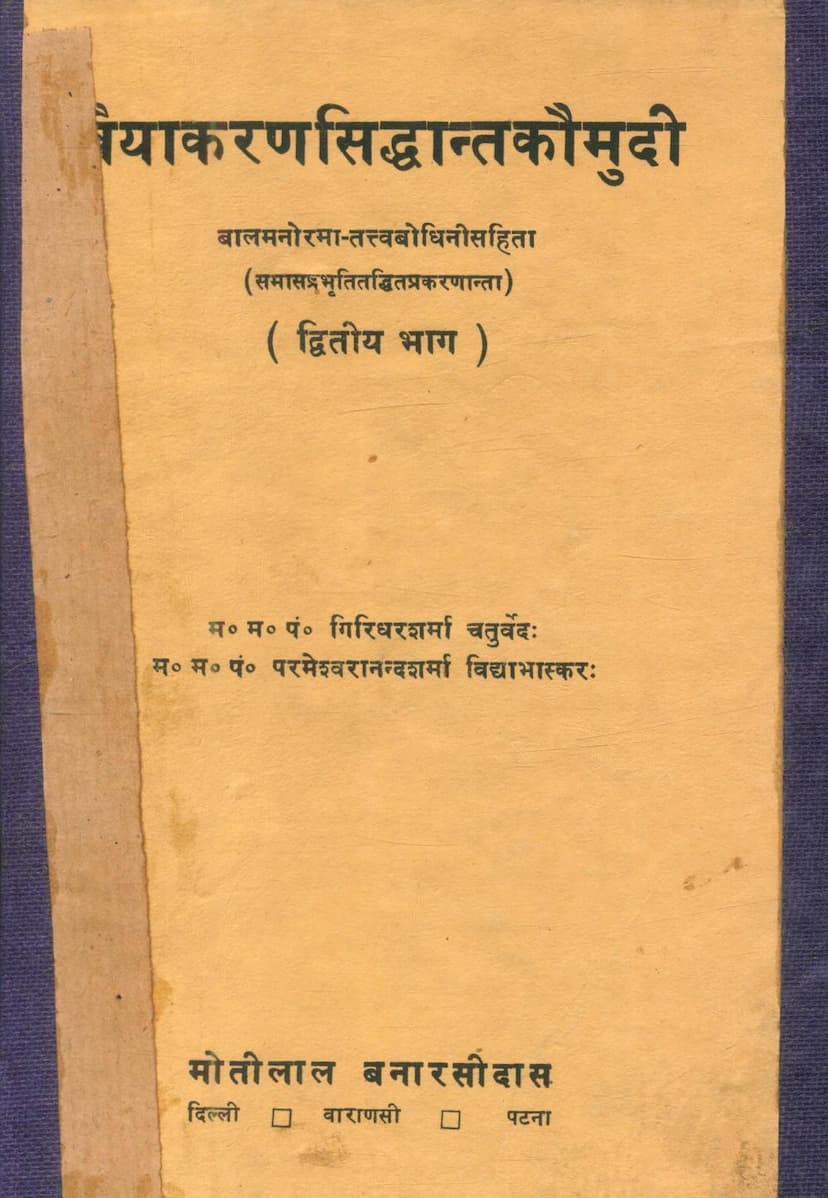Laghu Siddhant Kaumudi Part 02
Added to library: September 2, 2025

Summary
This comprehensive summary of the "Laghu Siddhanta Kaumudi Part 02" by Girdhar Sharma and Parmeshwaranand Sharma, as provided in the text, focuses on the grammatical rules related to compound words (समास) and the formation of words using suffixes (तद्धित). The text covers various types of compounds and their rules as per the Paninian grammatical system, along with the application of suffixes.
Here's a breakdown of the key areas covered, based on the provided Sanskrit text:
I. Compounds (समास)
The text details the formation of compounds according to Sanskrit grammar, primarily following the principles laid out in Panini's Ashtadhyayi. The main types of compounds discussed are:
- Avyayi-bhaava Samasa (अव्ययीभाव समास): Compounds where the first word is an indeclinable (अवयव) that determines the meaning. The text explains the rules for forming these compounds based on the meaning of the indeclinable, such as proximity (समीप), abundance (समृद्धि), deficiency (व्युद्धि), absence (अर्थाभाव), etc. Examples like upakrishna (near Krishna), samudra (full of the sea), avyaya (without time) are discussed.
- Tatpurusha Samasa (तत्पुरुष समास): Compounds where the second word is primary, and the first word (usually a noun in the genitive case) qualifies the second. The text elaborates on the various relationships the first word can have with the second, such as relation (षष्ठी), instrument (तृतीया), destination (चतुर्थी), separation (पञ्चमी), location (सप्तमी), etc. It covers numerous specific rules, including compounds formed with words like shrith (to be attached), ateeta (gone beyond), patita (fallen), krita (done), guna (quality), sadṛś (similar), etc. The text also discusses rules for compounds formed with numbers (संख्या), directions (दिक्), and the rules for Upapad (उपपद) compounds where a word before the verb root is compounded with the verb's product. Specific mention is made of Karmadharaya (कर्मधारय) and Dvigú (द्विगु) as sub-categories of Tatpurusha.
- Bahuvrihi Samasa (बहुव्रीहि समास): Compounds where the meaning of the entire compound refers to something outside of the words forming the compound. The text explains how these compounds describe a noun by its attributes. Examples like gajasā (having an elephant) and vitṛṣṇa (without thirst) are cited. It also covers rules related to the order of words, the use of the masculine form for feminine words, and exceptions.
- Dvandva Samasa (द्वन्द्व समास): Compounds where the words have a conjunctive relationship (e.g., using 'and'). The text explains the rules for agreement in number and gender, the order of words, and the formation of compounds with conjunctions and their exceptions. It details rules for different types of dvandva, such as itarayoga (mutual dependence) and samāhāra (group).
II. Suffixes (तद्धित)
The text covers various rules for adding suffixes to words to form new words, primarily in the context of forming words related to:
- Apatya (अपत्य): Suffixes related to offspring, descendants, and lineage. Rules for forming words like gārgēya (descendant of Garga), pailā (daughter of Paila), glouchukāyani (descendant of Gluchuka) are explained.
- Chāturarthika (चातुरर्थिक): Suffixes forming words related to various meanings like "belonging to," "made of," "related to," "as if," etc. Examples like kārpāśakī (related to Kārpāsa), audumbarim (from Udumbar), vaishavik (related to Vaishakha) are provided.
- Shaishika (शैषिक): Suffixes that are added in a general or residual sense when other specific rules do not apply. The text discusses rules for forming words related to general meanings, the usage of suffixes like sha, chha, vu, ñ, thak, etc., based on context and exceptions.
- Samāsaśraya Vidhi (समासाश्रयविधि): Rules for applying suffixes after a compound (samāsa) has been formed. This includes rules for suffixes that apply to compounds of specific types or with specific properties.
- Nipātanāni (निपातनानि): Rules where certain words are formed by inherent convention rather than by following the general grammatical rules. These are treated as exceptions or special cases.
III. General Grammatical Concepts
Throughout the text, several important grammatical concepts are applied and explained in the context of word formation:
- Samarthapada Vidhi (समर्थः पदविधिः): The rule that only words that are in a meaningful relationship (samartha) can be compounded.
- Anekam Anyapadārthe (अनेकमन्यपदार्थे): The principle of Bahuvrihi where the meaning of the compound refers to an external noun.
- Prathama Nirdishta Samāsa Upasarjanam (प्रथमानिर्दिष्टं समास उपसर्जनम्): The first word in a compound that is specified in the sutra becomes the upasarga (subordinate element).
- Upasargan Purvam (उपसर्जनं पूर्वम्): The upasarga comes first in the compound.
- Sāmayāchika Samāsa (समयाचिका समास): Compounds formed with indeclinables that convey concepts like proximity, time, etc.
- Nitya Samāsa (नित्यसमास): Compounds that are always formed and cannot be separated into their constituent words in a meaningful way.
- Vākyam (वाक्यम्): Sentence or phrase used for illustrating the meaning or derivation of a compound.
- Aluk Samāsa (अलुक् समास): Compounds where the case ending of a word is not dropped.
- Samāsānta (समासান্ত): Suffixes added to the end of a compound word.
- Nipātana (निपातन): Irregular formations or exceptions to rules that are considered as intrinsically ordained.
- Sandhi (सन्धि): Rules of phonetic change at the juncture of words, which are often applied before or after compounding.
- Vṛddhi (वृद्धि), Guṇa (गुण), Ādeśa (आदेश), etc.: Phonetic changes applied according to Paninian rules.
The book provides a meticulous and systematic explanation of these rules, often citing the original sutras from the Ashtadhyayi and offering detailed analysis and examples. The inclusion of commentaries like "Balamanorama" and "Tattvabodhini" suggests that this text is a detailed study guide for Sanskrit grammar, particularly for those focused on the Pāṇinian tradition.
In essence, "Laghu Siddhanta Kaumudi Part 02" serves as a foundational text for understanding how Sanskrit words are constructed through the complex and precise rules of Samasa and Taddhita.